Operation mechanism of light-emitting electrochemical cells: A cheaper alternative to organic light-emitting diodes
![Organic materials and device structures for light-emitting electrochemical cells. a, b The chemical structures of Super Yellow (SY) (a), an organic semiconductor yellow light-emitting material, and trihexyltetradecylphosphonium bis(trifluoromethylsulfonyl)amide ([P66614][TFSI]) (b), an ionic liquid. c Cross section of the LEC used in this study. d Schematic structure of the LEC used in this study. Credit: Communications Materials (2023). DOI: 10.1038/s43246-023-00366-3 Operation mechanism of light-emitting electrochemical cells: A cheaper alternative to organic light-emitting diodes](https://scx1.b-cdn.net/csz/news/800a/2023/operation-mechanism-of.jpg)
Light-emitting electrochemical cells (LECs) are a type of organic light-emitting devices. Compared to organic light-emitting diodes (OLEDs), LECs exhibit a simpler structure, greater flexibility, and can be manufactured at lower costs using the printing technology.
Moreover, LECs require lower voltages than OLEDs for operation, making them an appealing prospect for the next generation of energy-saving light-emitting devices. Despite their potential, the microscopic-level functioning of these devices remains unclear, impeding research on their practical applications.
Herein, the researchers investigated LECs made from Super Yellow, a commonly used organic light-emitting material. By employing the electron spin resonance (ESR) method, they examined the spin states of the charges within the LECs during operation. They noted that as the voltage applied to the LECs was increased, emission and ESR increased.
Further, theoretical analysis of the observed signals led to the conclusion that the increasing ESR originated from holes and electrons being electrochemically doped (injected) into Super Yellow. Interestingly, the correlation between the progress of this doping and the increase in luminance suggests that as part of the device’s operation mechanism, these doped charges spread across the light-emitting layer.
The techniques developed by this research team provide unprecedented molecular-level insights into the operation mechanisms of LECs. It is anticipated that these insights can help to effectively drive the development of affordable, environment-friendly light-emitting devices.
The research is published in the journal Communications Materials.
More information:
Junya Katsumata et al, Investigating the operation mechanism of light-emitting electrochemical cells through operando observations of spin states, Communications Materials (2023). DOI: 10.1038/s43246-023-00366-3
Citation:
Operation mechanism of light-emitting electrochemical cells: A cheaper alternative to organic light-emitting diodes (2023, June 5)
retrieved 5 June 2023
from https://techxplore.com/news/2023-06-mechanism-light-emitting-electrochemical-cells-cheaper.html
This document is subject to copyright. Apart from any fair dealing for the purpose of private study or research, no
part may be reproduced without the written permission. The content is provided for information purposes only.
For all the latest Technology News Click Here
For the latest news and updates, follow us on Google News.

